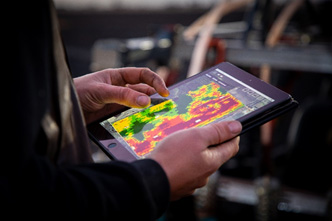Planning and purchasing AgTech
A guide for farmers on AgTech investment
Introduction
 Investing in AgTech requires careful planning to ensure it aligns with your farm's needs and offers a solid return on investment. This guide outlines the essentials for farmers to consider in purchasing AgTech products.
Investing in AgTech requires careful planning to ensure it aligns with your farm's needs and offers a solid return on investment. This guide outlines the essentials for farmers to consider in purchasing AgTech products.
Define your objectives
Before investing, identify specific challenges you aim to address for your farm business. Whether it's time management, automation, improved data collection, or reduced costs, clarity on your goals is crucial.
Research and opportunities
Explore AgTech options by consulting with other farmers, service providers, and online groups. Understand the upfront and ongoing costs, installation requirements, and potential benefits. Farmers using AgTech report improvements in efficiency, productivity, safety, decision confidence, and overall quality of life.
Examine various aspects, including data analysis, network requirements, mobility and durability. Connect with other farmers to learn about their experiences with different AgTech solutions. Consider factors like does it need to withstand exposure to weather and animals.
Planning a 'Smart Farm'
Map your requirements for the AgTech devices to function properly. Consider network costs, data transmission needs, power sources, and device compatibility. Check how useful the dashboards are, what are the real-time decision-making capabilities, how much can you customise data analysis, and address privacy concerns.
Creating an AgTech project plan
Develop a comprehensive plan based on your farm's needs and goals. Use tools like the Getting into AgTech eLearn series to guide your decision-making process.
Key considerations for AgTech adoption:
- Clearly define your objectives and how AgTech will be used on your farm.
- Conduct thorough research on device types and their suitability for specific tasks.
- Pay attention to installation considerations such as network coverage, device protection, and location.
- Evaluate established and emerging companies, consider the after-sales service and support available to you.
- Understand power and data management options, including solar, battery, and mains power.
- Plan for ongoing maintenance, consider factors like pest control and technical support.
Assessing costs and benefits
- Investigate the total costs of the AgTech product, both upfront and ongoing costs.
- Upfront costs may include the purchase price and installation costs. Some purchases may come with free installation, while others many involve a service fee, plus additional groundworks or connectivity infrastructure.
- Ongoing costs may include monthly or annual connectivity charges or subscriptions, as well as an estimate of repairs and maintenance over time.
- Benefits may include productivity gains, reduced operating costs, reduced inputs or time savings.
- Many new technologies offer time savings on specific tasks, for example, checking stock water levels in person.
Time savings can be assessed as a labour saving by calculating:
Labour saving (per year) = ………..hours saved (per year) x $......... hourly work rate.
You might start of by assessing the amount of hours saved per week and multiply them up to ‘per year’ (X52).
Suggested work rates are:
- $100-$150 per hour: Management (accounting, consulting, farm business planning)
- $70-$100 per hour: Skilled Labour (fencing contractor, plumber, shearer)
- $30-$50 per hour: Semi-skilled labour (farm hand)
- Know the likely life of the equipment. How long will it last before requiring replacement? Are you likely to gain sufficient benefit in that time?
- While ‘simple paybacks’ are often quoted, they are rough and usually underestimate or exclude additional costs. An accountant can assist with a more comprehensive analysis that considers interest rates, ongoing subscriptions, and repairs and maintenance. This can be worthwhile for medium to large capital investments.
AgTech investment checklist for farmers
The following checklist provides a guide through the decision-making process when choosing AgTech for your farm.
1. Define objectives
2. Research and opportunities
3. Thorough research
4. Planning a 'Smart Farm'
5. Creating an AgTech project plan
6. Key considerations for AgTech adoption
Conclusion
With a well-defined plan, farmers can ensure their investment in AgTech delivers substantial benefits, making informed decisions that positively impact their businesses. Additional resources, including on-farm demos and industry events, can provide valuable insights and support for successful AgTech integration.